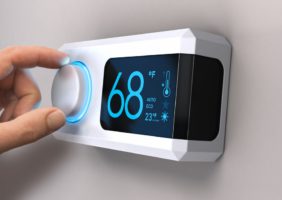
Winter is coming, which means people across the country will soon fire up their heaters to keep comfortable as the temperatures drop. But, many of these people will end up wasting energy by setting their thermostats at the wrong temperature. The winter season doesn’t officially start until December 21st, so now is the perfect time to learn how to set your thermostats to save energy and keep heating costs low.
The Most Energy Efficient Temperatures For the Winter Season
There’s no need to overheat your home by setting the thermostat to 70 or 75 degrees Fahrenheit. According to the U.S. Department of Energy, it is best to set the thermostat at 68 degrees Fahrenheit during the cold winter months. Keeping your home at this temperature will keep you warm without using too much energy, so your monthly heating bills should be lower than usual.
The Department of Energy also recommends dialing the thermostat down a few notches when no one is home or when everyone within the home is sleeping. Turning the dial down by at least 7 degrees Fahrenheit during these times can save a significant amount of energy. This strategy can lead to financial gains, too! It’s estimated that adjusting the thermostat when no one is home or everyone is sleeping can help you save up to 10% on your utility bills.
How to Set Energy Efficient Temperatures in the Winter
For many people, winter is the busiest season of the year. It’s hard to remember to adjust the thermostat throughout the day when you’re wrapped up in the hustle and bustle of the holiday season. But fortunately, there’s an easy way to implement this strategy.
Plan on installing a programmable thermostat before winter arrives. Program the thermostat to keep your home at 68 degrees Fahrenheit at all hours except for those that you are at work or asleep. Set the thermostat to automatically dial the temperature down by 7 degrees Fahrenheit during these hours so you do not need to manually make these adjustments
How to Keep Temperatures Consistent Throughout the Home
Some homeowners find that the thermostat says 68 degrees Fahrenheit, but it feels much colder in certain areas of their home. If one room is significantly colder than another, it’s very likely that it needs more insulation to keep the warm air inside your home.
Adding insulation will not only make living inside your home more comfortable, but it will also reduce heating costs. How? Insulation reduces heat loss, so your heater will not need to work as hard in order to keep your home at a comfortable temperature. Since the heater isn’t working as hard, it isn’t consuming as much energy, either. Consider tackling this home improvement project before the temperatures start to drop so you can stay warm until spring without wasting energy.
You’re probably used to seeing a spike in your utility bills during the winter, but cold weather does not need to lead to significantly higher bills. Follow these tips so you can use energy as efficiently as possible and keep your utility costs low this winter.



